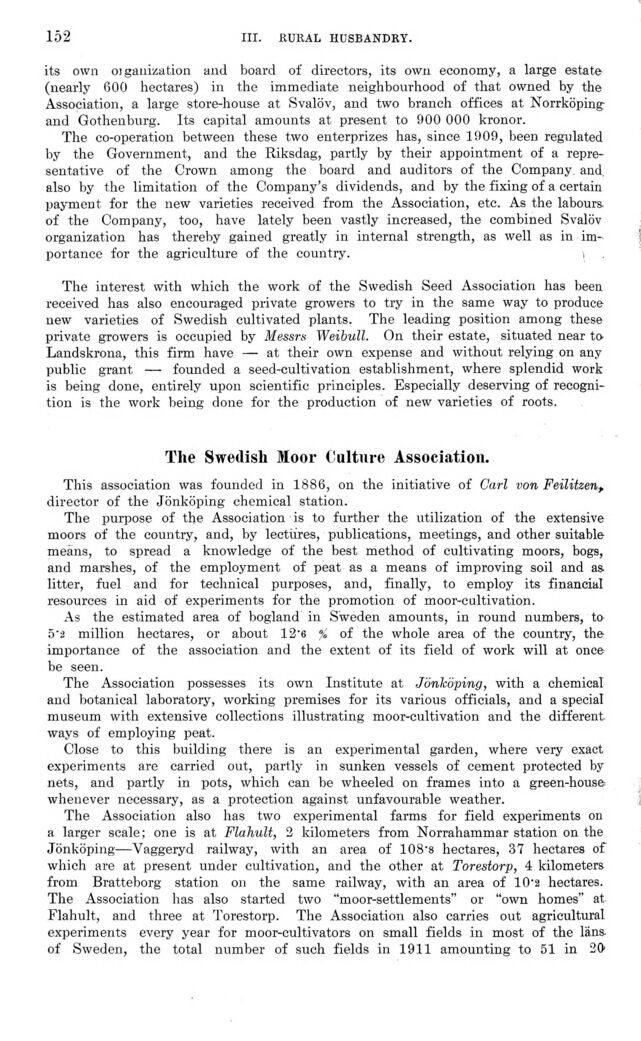
Full resolution (JPEG) - On this page / på denna sida - III. Rural Husbandry. Introd. by H. Juhlin Dannfelt - 4. Public and Private Institutions for the Advancement of Agriculture. Introd. by W. Flach - Sowing Seed Question. By Hj. Nilsson - Swedish Moor Culture Association. By Hj. von Feilitzen

<< prev. page << föreg. sida << >> nästa sida >> next page >>
Below is the raw OCR text
from the above scanned image.
Do you see an error? Proofread the page now!
Här nedan syns maskintolkade texten från faksimilbilden ovan.
Ser du något fel? Korrekturläs sidan nu!
This page has never been proofread. / Denna sida har aldrig korrekturlästs.
1-2-2
iii. rural husbandry.
its own oiganization and board of directors, its own economy, a large estate
(nearly 600 hectares) in the immediate neighbourhood of that owned by the
Association, a large store-house at Svalöv, and two branch offices at Norrköping
and Gothenburg. Its capital amounts at present to 900 000 kronor.
The co-operation between these two enterprizes has, since 1909, been regulated
by the Government, and the Riksdag, partly by their appointment of a
representative of the Crown among the board and auditors of the Company, and
also by the limitation of the Company’s dividends, and by the fixing of a certain
payment for the new varieties received from the Association, etc. As the labours
of the Company, too, have lately been vastly increased, the combined Svalöv
organization has thereby gained greatly in internal strength, as well as in
importance for the agriculture of the country.
The interest with which the work of the Swedish Seed Association has been
received has also encouraged private growers to try in the same way to produce
uew varieties of Swedish cultivated plants. The leading position among these
private growers is occupied by Messrs Weibull. On their estate, situated near
to-Landskrona, this firm have — at their own expense and without relying on any
public grant — founded a seed-cultivation establishment, where splendid work
is being done, entirely upon scientific principles. Especially deserving of
recognition is the work being done for the production of new varieties of roots.
The Swedish Moor Culture Association.
This association was founded in 1886, on the initiative of Carl von Feilitzen,
director of the Jönköping chemical station.
The purpose of the Association is to further the utilization of the extensive
moors of the country, and, by lectures, publications, meetings, and other suitable
means, to spread a knowledge of the best method of cultivating moors, bogs,
and marshes, of the employment of peat as a means of improving soil and
as-litter, fuel and for technical purposes, and, finally, to employ its financial
resources in aid of experiments for the promotion of moor-cultivation.
As the estimated area of bogland in Sweden amounts, in round numbers,
to-5-2 million hectares, or about 12’6 % of the whole area of the country, the
importance of the association and the extent of its field of work will at
once-be seen.
The Association possesses its own Institute at Jönköping, with a chemical
and botanical laboratory, working premises for its various officials, and a special
museum with extensive collections illustrating moor-cultivation and the different
ways of employing peat.
Close to this building there is an experimental garden, where very exact
experiments are carried out, partly in sunken vessels of cement protected by
nets, and partly in pots, which can be wheeled on frames into a green-house
whenever necessary, as a protection against unfavourable weather.
The Association also has two experimental farms for field experiments on
a larger scale; one is at Flahult, 2 kilometers from Norrahammar station on the
Jönköping—Vaggeryd railway, with an area of 108’s hectares, 37 hectares of
which are at present under cultivation, and the other at Torestorp, 4 kilometers
from Bratteborg station on the same railway, with an area of 10’2 hectares.
The Association has also started two "moor-settlements" or "own homes" at
Flahult, and three at Torestorp. The Association also carries out agricultural
experiments every year for moor-cultivators on small fields in most of the
läns-of Sweden, the total number of such fields in 1911 amounting to 51 in 201
<< prev. page << föreg. sida << >> nästa sida >> next page >>